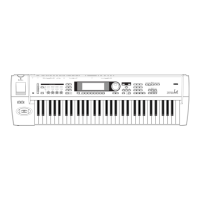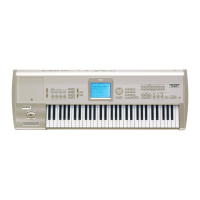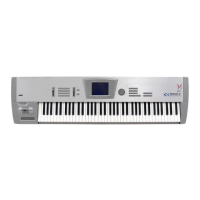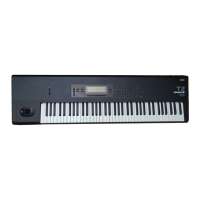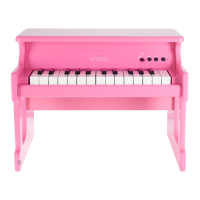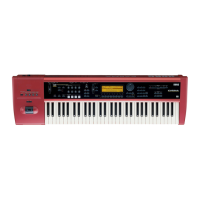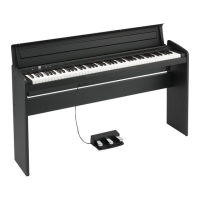TRITON Le EasyStart
6
TRITON Le “QuickTips”
Discovering “hidden” arpeggio patterns in Program and Combi modes:
When selecting some sounds, the ARP ON/OFF key is unlit, and with other sounds, the key automatically lights, and the arpeggio pattern(s) trigger
as soon as you play the keyboard. Note that there are patterns pre-assigned to every Program and Combination in the TRITON Le. Simply press to
turn the ARP key ON (lit), and then play the keyboard to trigger the assigned patterns.
Trying out new arpeggio patterns in Programs and Combis:
After selecting a Program and triggering the assigned arpeggio pattern: Press the [F3] key (“Arp”) Ä CURSOR ▼to highlight the “Pattern” name
assigned
Ä Press the [INC] key or rotate the DIAL to select new patterns. (Basic Guide, page 27)
After selecting a Combination and triggering the assigned arpeggio pattern(s): Press the [F4] key, and the “check boxes” in the display will indicate
which patterns are set to trigger (A, B or both)
Ä Select either with the [F4] or [F5] keys, then Ä CURSOR ▼to highlight the “Pattern” name
assigned
Ä Press the [INC] key or rotate the DIAL to select new patterns. (Basic Guide, page 28)
Checking the current ROM version # and installed EXB-SMPL option in the TRITON Le:
On Power-up, the display will indicate the current software version and all installed options. To download the newest operating systems as they
become available, visit www.korg.com
A few words on user- installation of the EXB-SMPL Sampling option:
The Sampling option includes the EXB-SMPL board/SCSI connector, a 16 Mbyte DRAM SIMM module and screws. You can add another 16 Mbyte
or 32 Mbyte SIMM module for a total of 32 or 48 Mbyte sample ram, or reach the maximum sample memory capacity of 64 Mbytes by removing the
16 Mbyte SIMM module, and installing 2- 32 Mbyte SIMM modules. (Specific instructions on how to easily- install this option can be found in the
Parameter Guide, page 254)
To adjust the display contrast:
Press the [GLOBAL] key Ä Press [F2] (“Pref”) Ä CURSOR to “LCD Contrast” and use the DIAL to set as needed.
Save your valuable data!
Any edits you make to Programs, Combinations, Drumkits or Global parameters can be written to internal memory and retained on power-you’re
your songs and samples will not be retained on power-off, however. Make sure that you back up all of your valuable data to SmartMedia™ or via
SCSI, if the EXB-SMPL option is installed! For more information, see the Basic Guide, page 41.
Important Owner’s Manual References
Basic Program and Combination editing Basic Guide, pages 48 and 56
Copying a Combination to the Sequencer
Basic Guide, page 75
Creating and recording RPPR (Realtime Pattern Play/Record)
Basic Guide, page 73
Sampling: Converting a Multisample to a Program
Basic Guide, page 91
Sample Looping, Time Slicing and advanced sample editing Basic Guide, pg 91-Param Guide, pgs 98-117
Creating a user arpeggio pattern
Basic Guide, pg 103
Effect Guide
Param Guide, pg 155
Alternate Modulation
Param Guide, pg 211
Dynamic Modulation
Param Guide, pg 217
Routing Individual Outputs
Param Guide, pg 162
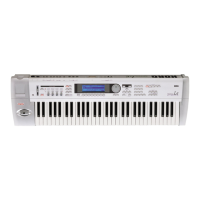
